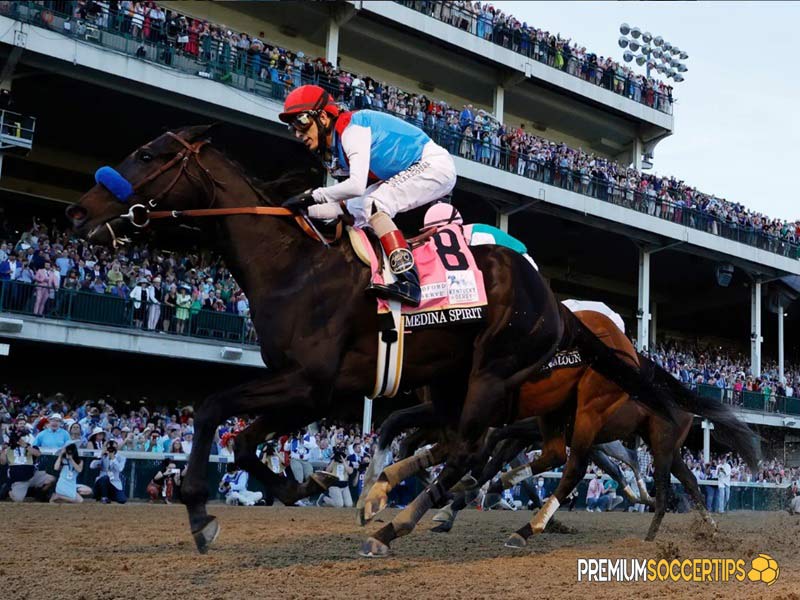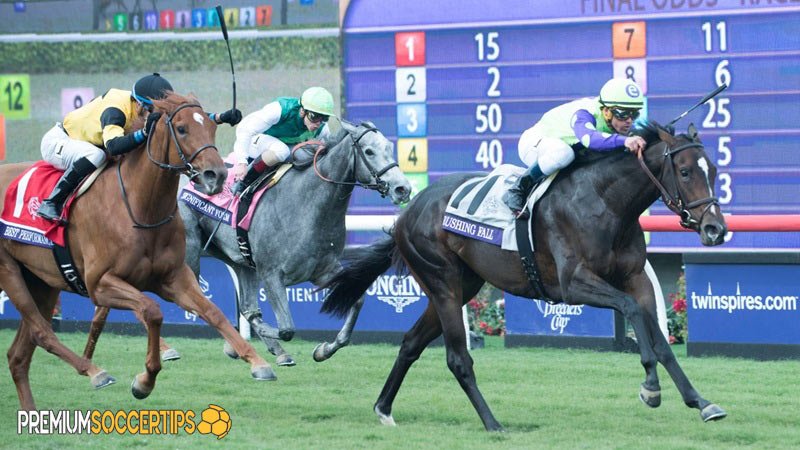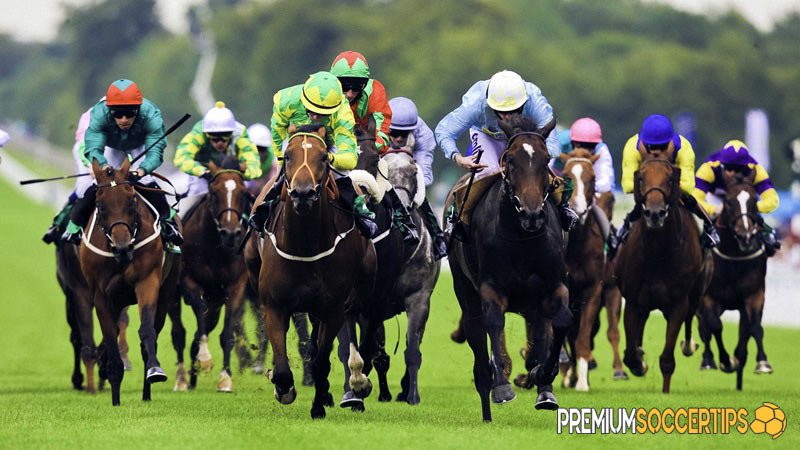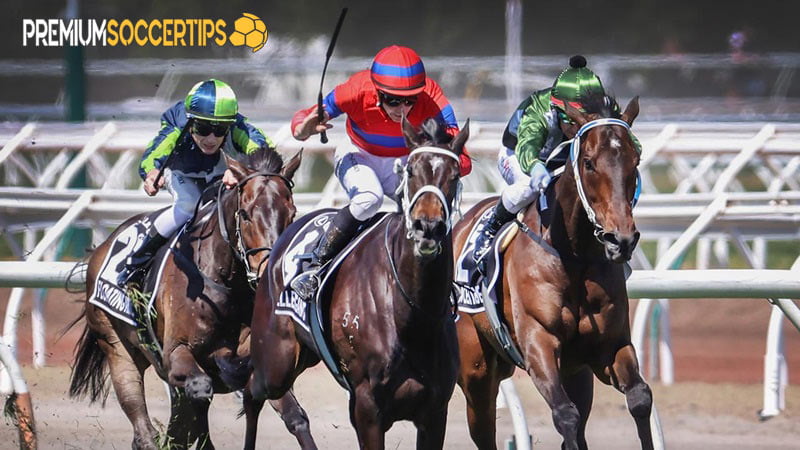Share a guide on how to bet on horse racing for beginners
Horse racing is becoming increasingly popular with audiences, and horse racing betting plays a significant role. We will discuss online betting and horse racing betting platforms, along with new rewards for new users. Follow premiumsoccertips article below to explore the world of online horse racing betting and how to bet on horse racing.
How to bet on horse racing
Firstly, you need to choose a reputable bookmaker to participate in horse racing betting. Then, you’ll need to find the race or event you want to bet on. The variety of races you can choose from is often limitless in the United States, as well as including the United Kingdom, South Africa, Canada, the Middle East, and other countries.
Once you’ve selected the race, you need to choose the horse you want to bet on. You should apply research to your betting, and we’ve included an expanded betting strategy section to help you with this.

Next is deciding on the amount you want to wager at the odds you deem valuable. There are dozens of bet types we’ll address later, but if you’re new, it’s best to start with win or place markets, as other bet types (such as exotic bets) can initially be somewhat complex to understand.
Popular Types of Horse Racing Bets
One of the most important factors in understanding how to bet on horse racing is the various types of horse racing bets. We’ve made every effort to explain some of the most common issues for you here:
Win
This is easily the most popular and simplest type of bet when learning how to bet on horse racing. It simply involves betting on the horse you’re wagering on to win the race outright, to finish first overall in the race. If the horse you bet on finishes in any position other than first place, the bet is considered lost.
Place
Choosing a horse to place is another popular and straightforward way of betting, very similar to picking a horse to win. However, here, the second position is included along with the first in terms of winning selections. So, if the horse you choose finishes first or second, your bet wins. If it finishes third or any other position, your bet loses.
Show
Finally, betting on a horse to show is similar to the first two types of bets, only including the third position. If the horse you choose finishes first, second, or third, it’s a winning bet. Anywhere else in the race, and it’s a losing bet.
Across the Board
Betting on a horse across the board means you’re betting on a horse to finish first, second, or third, but the payouts will vary depending on which of those top finishes it achieves. The horse finishing first will earn all three top finishes. The horse finishing second will earn a place and a show. And finally, the horse finishing third will only get the show money.
Other Popular Horse Racing Bets
There are many other types of horse racing bets for you to choose from besides the four types we’ve listed above. Some other popular ones include exacta box, exacta box, trifecta box, trifecta box, superfecta box, and superfecta.
Types of Horse Racing
There are four different types of horse racing: Flat racing; National Hunt racing; Harness racing, and Endurance racing. In the United Kingdom, Flat and National Hunt races are prominent categories with widespread coverage. Both are regularly televised, featured in media, and reported on.
Flat Racing
This type (or ‘code’) of horse racing is described by its name: Flat races take place on flat tracks with no obstacles. These races focus on speed rather than agility in jumping and can range in distance from five furlongs to two miles.
Horses racing over five furlongs are called sprinters, while those racing from a mile and a half to two miles are termed ‘stayers’. Middle-distance horses run over seven furlongs to a mile.

Flat racehorses can begin racing at the age of two and may be colts (entire males under 5 years old), fillies (females under 5 years old), geldings (castrated males), mares (females over 5 years old), or horses (entire males over 5 years old).
Flat races take place on both turf and all-weather surfaces. The turf season runs from late spring to autumn, and the all-weather season extends throughout the winter.
National Hunt Racing (or ‘Jump’)
This discipline dictates races where horses must negotiate obstacles – these can be hurdles (smaller jumps designed for speed) or steeplechase fences (larger jumps requiring good jumping ability and strength).
National Hunt races are longer than Flat races, ranging from two miles to four miles, and are run at a slower pace than Flat racing. National Hunt horses can be geldings, fillies, or mares. Colts and entire horses are not seen in National Hunt races.
Within this code, there are many races termed ‘National Hunt Flat races’ – these are races for young, inexperienced horses that don’t encounter obstacles and are designed to provide education for runners.
Harness Racing
Present in the UK, although not as widespread, harness racing still enjoys television coverage and widespread following in Europe, Australia, and the United States. In these races, horses are harnessed and driven around the track rather than ridden. These horses can trot at speeds of up to twenty miles per hour and, like Flat and National Hunt horses, must be properly bred and trained to compete.
Endurance Racing
Similar to Harness racing, endurance racing also takes place in the UK but isn’t as widely publicized or noticed by the media. Endurance races can range from 5 to 150 miles over challenging terrain and often last from one to three days.
Explaining Odds and Betting Odds in Horse Racing
The final step in understanding how to bet on horse racing is understanding odds and betting odds. In horse racing, unlike traditional sports betting, a pari-mutuel system is used, meaning all the money wagered is pooled together. The amount of money then determines the odds for each horse.

For example, the horse with the most wagers in a specific event will be the favorite bet. This can certainly shift payouts in a certain way because initially, you may bet on a horse to win with odds of 10-1, but it could start the race with odds of 5-1. Conversely, you could bet on a horse with odds of 5-1 and then be rewarded if their odds increase to 10-1 before the race begins.
How to Read Betting Odds and Horse Racing Odds
In horse racing, the betting odds are displayed in fractional odds rather than decimal or American odds. For example, instead of a horse being listed at +200, it would be listed at 2-1. Payouts still work similarly to regular sports betting, just with a slightly different appearance. Betting on a horse to win with odds of 2-1 would earn you $20 from a $10 bet. Betting on a horse to win with odds of 10-1 would earn you $100 from a $10 bet.
Horse Racing Betting Strategy
Foundation
Whether you’re a jockey or a trainer, in the end, it all comes down to the horses themselves. The first thing to do before betting on horse racing is to research the experience, performance, and other statistical data surrounding the horse.
Both recent form and form at a specific venue are valuable insights when deciding which horse to bet on, along with the horse’s style and current condition of running.
Intermediate Level
Both jockeys and trainers ultimately have a significant impact on whether a horse wins or loses. This may be more true for the trainer’s aspect, as jockeys often aren’t locked into any particular horse, but the best ones will be assigned the best horses to ride.
However, horse trainers work tirelessly to get their horses in the best possible condition. It’s always wise to check the combination of horse/jockey/trainer before the race.
Advanced Level
The gate position can be one of the most crucial external factors affecting a horse’s performance in horse racing. The worse the horse’s gate position, the more ground it has to cover.

This is highly important as every second counts in a sport like this. Gate positions vary at all racetracks, so be sure to check both the gate position information and the actual gate position of the horse you’re interested in.
Things to Avoid When Betting on Horse Racing
- Over-betting.
- Not conducting enough research.
- Betting exclusively on the favorite.
- Not comparing betting odds between races.
- Overlooking track conditions.
- Betting solely based on a single jockey.
Conclude
In conclusion, when it comes to betting on horse racing, it’s essential to approach it with caution and strategy. Avoiding common pitfalls such as over-betting, neglecting thorough research, relying solely on favorites, failing to compare betting odds, overlooking track conditions, and betting solely based on a single jockey can significantly improve your chances of success. By taking the time to analyze data, consider various factors, and make informed decisions, you can enhance your experience and potentially increase your winnings in horse racing betting. Remember, patience, diligence, and careful consideration are key components of a successful betting strategy in the thrilling world of horse racing.
See more: How to Bet on Greyhounds: Practical Strategies for Beginners








